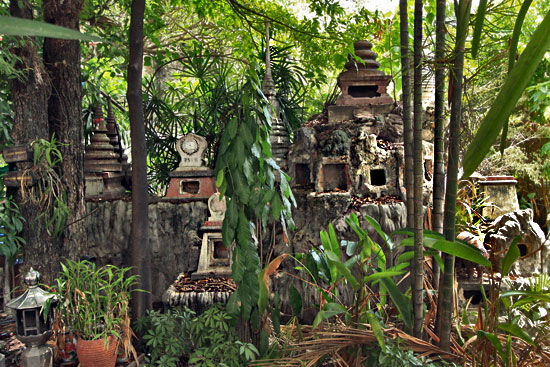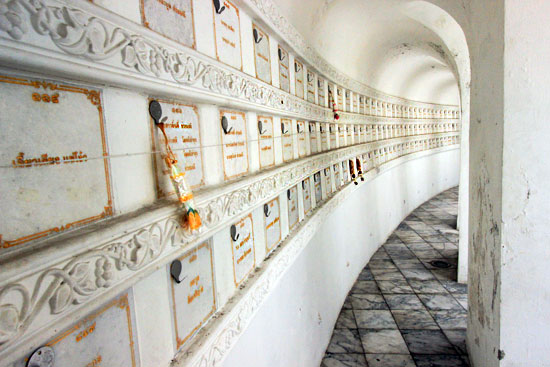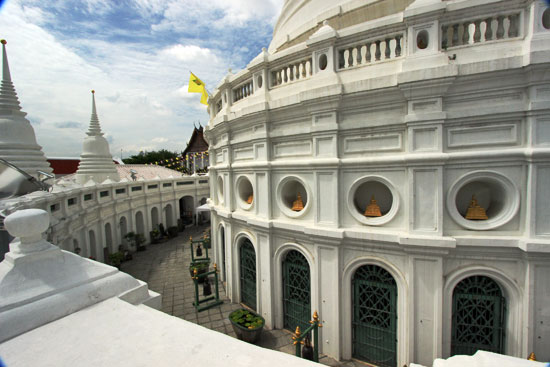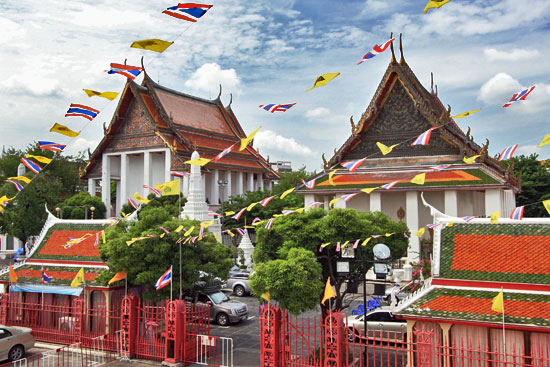According to the Office of National Buddhism there are 40,717 Wats (Buddhist temples) in Thailand of which 33,902 are in current use. Almost every one of them includes a Chedi (also known as a Stupa or pagoda), a building that in most cases is said to hold a relic of the Buddha. I had often fleetingly wondered about this claim; surely Buddha’s cremated remains could not possibly have produced enough material to fill all the Wats in all the Buddhist countries around the world..
A few weeks ago, I found myself shopping in shopping in Bangkok once again. Seeking something new to do in one of my favorite cities, I jumped at a suggestion of my friend, Larry Bosco, to visit Wat Prayurawongsawas, commonly known as Wat Prayoon, in an off-the-beaten-track location on the west bank of the Chao Phraya River. The draw was not the Wat itself so much as a man-made mountain, situated in the middle of a pond at the front of the monastery, the design of which was inspired by a mound of melted candle wax that caught the eye of King Rama III. The mountain is surrounded by small pavilions that hold Buddha-images, dotted with caves and niches, and surmounted by a bronze pagoda, but most come to see the turtles that devout Buddhists release into the pond as an act of merit. Unfortunately, when we arrived Turtle Mountain was undergoing renovations and was closed to the public. The best we could do was peek between the iron bars of its enclosing fence.

Instead, I turned my attention to the numerous other buildings on site and discovered that a mountain modeled after melted wax was not the only unique aspect of this Wat. A long lane leading to the inner courtyard was bordered by a red iron fence constructed in the shape of ancient lances, swords and axes. Local legend says the fence was constructed with iron melted down from 30,000 axes, 3 cannons, and 300,000 lances, earning this Wat the nickname of Wat Rua Lek (Iron-fenced Monastery). Though strange for a religious facility devoted to peace and prayer, there is a plausible explanation for the fence. It was ordered from the United Kingdom on behalf of King Rama III by Somdet Chao Phraya Borom Maha Prayarawong, the builder of the Wat, who was also Minister in charge of the Royal Treasury, Foreign Affairs and Defense. He intended to donate it for use around the Grand Palace but when the King rejected his offer the minister asked and was granted permission to install the fence at Wat Prayoon.

The narrow lane led to a spacious courtyard dominated by the elegant Phra Boromthat Maha Chedi, the tallest in Bangkok and only one constructed in the Ayutthaya style marked by the familiar shape of an upside down bell. Alternating Thai and Buddhist flags cascaded down from the mid-levels of the Chedi, fluttering navy, red and yellow in the gentle breeze and contrasting sharply with the blindingly white Chedi, fluffy clouds and pale blue skies. Before circumnavigating the enormous pagoda, I stepped across the threshold of a small museum at the base of the Chedi and discovered to my delight that I could go inside! Though I had visited dozens of Chedis around Southeast Asia, never before had I been allowed interior access, where Buddha’s relics are said to be enshrined.

After circuiting the interior walkway and examining the cremation vaults that lined the walls, I climbed the porch of the Chedi’s enclosing ring wall for a bird’s eye view. Eighteen bell-shaped pagodas perched atop the ring wall, miniature reflections of the main spire that soared nearly 200 feet high before me, while 55 golden Buddhas gazed serenely back at me from niches carved in the base of the pagoda. In the opposite direction were stunning views of the side-by-side Vihara (assembly hall) and Uposatha (ordination hall) on the other side of the courtyard. But I had saved the best for last. Descending to the ground floor, I ducked into the Chedi itself and climbed the dark, narrow stairway leading into the bowels of the 184-year old structure.

Inside, I blinked and waited for my eyes to adjust to the dim light, surprised to see that the gleaming white Chedi was actually constructed of terra cotta bricks, painstakingly set and mortarted in ever-diminishing diameters to give the Chedi its spire design. I craned my neck; the top was lost in darkness but spotlights illuminated a series of golden Buddha statues inserted at intervals into niches. The brick walls seemed fragile, as if they could topple at any moment and I was comforted by the presence of zig-zag wooden support beams that braced the interior.

That these walls survived is something of a miracle. Lightning struck and damaged the top of Phra Boromathat Maha Chedi in 1871 and it remained in this condition for 47 years before being repaired. The pagoda continued to fall into disrepair; by the century mark the wooden framing timbers had been weakened by boring insects and huge cracks in the walls threatened collapse, yet it was another 78 years before repairs began in 2006.
It had long been believed that the tenth abbot of the Wat, Phra Prakrommuni (Plian), had enshrined the Buddha’s relics in the top section of the pagoda in 1907, however it wasn’t until the restoration work was finally initiated in 2006 that their existence was confirmed. According to displays in the museum, Buddha relics and 300 Buddha statues were discovered on November 5, 2007 in crypt one of the great pagoda, with additional Buddha relics and a further thousand Buddha statues and amulets being found two days later in crypt number two. One year later, Thailand’s Department of Fine Arts confirmed the authenticity of the pieces, stating that they were of “immense cultural value.” Once again, I wondered about these so-called relics, and this time I had to get to the bottom of the mystery.
It is said that upon the death of the present Lord Buddha, Shakyamuni Gautama, his body was cremated and its remains were separated into eight relic parts, which were distributed to Buddhist representatives of eight north Indian countries. Representatives from an additional two Buddhist embassies arrived after the division had been made and so were given ashes from the funeral pyre. The relics, consisting of teeth, bones, bone fragments, fingernails and hair, were enshrined in Chedis until, in the third century B.C., the Emperor Ashoka collected the relics and further divided them into 84,000 portions, vowing to erect a Chedi for each portion somewhere in his great empire.

Per the Compact Oxford English Dictionary, the word relic means: an object of interest surviving from an earlier time; a surviving but outdated object, custom, or belief; or a part of a holy person’s body or belongings kept and revered after their death. The term “Buddha relics,” as used in Thailand, includes actual remains of parts of Buddha’s body; actual objects used, owned or closely associated with Buddha; and dharma relics, which are anything that recorded Lord Buddha’s teachings. Additionally, sacred relics enshrined in Chedis or Stupas are often cremation ashes from Arahats, disciples of Buddhism who have reached total awakening and attained Nirvana.

The actual remains of Buddha’s body are further divided into two classes: those that originated from Lord Buddha (not from his disciples) and look like bone, and bones or any part of the body such as hair, nail, teeth, skin, blood, etc. which are different to those of ordinary people, and may be from disciples. These latter relics resembles pebble, stone, glass, diamond, etc. In Thailand, actual Buddha relics that look like bone are found at only two Wats: the Golden Mount of Wat Sraket in Bangkok and the Chedi Sri Mahathat of Wat Phra Sri Mahathat, Bangkhen. All other relics are of the kind that have morphed into multi-color clear or opaque beads that resemble rice grains, cabbage seeds and beans.
Though clearly not relics of Siddhartha Gautama, the relics discovered at Wat Prayoon are nevertheless considered to be holy representations of Lord Buddha. Her Royal Highness Princess Sirindhon presided over the re-enshrinement ceremony for four pieces of the Buddha’s relics in the Chedi on the 11th of December 2008. An additional five pieces of the Buddha’s relics found during the renovations are enshrined in the Vihara, enclosed in a glass case that sits in front of the 700-year old Phra Phutthanak buddha that dominates the hall.
How to Visit Wat Prayoon:
Take the BTS (Sky Train) Silom Line to Saphan Taksin. Exit from the station, walking in the same direction as the train was traveling. At the ground level walk straight ahead, about a block to the Chao Phraya River, and take a local boat (not the tourist boat) to Memorial Bridge. Cross under the bridge and walk up the stairs, arriving on the north side of the bridge. Walk across the bridge to the west side of the river. You will see the tall white Chedi as you cross the river; it is a short walk from the bridge.

Amazing place!!!!
Wat Prayoon, the cultures, structures of Buddhist sculptures are quite amazing.
What a beautiful complex – there’s probably a similar mystery in Catholic tradition around how so many fragments of the holy cross could be found in churches throughout the world
The ideas of relics intrigues me. There always appears to be more relics than humanly make sense. Mnay Christian churches and cathedrals claims parts of the cross, saints of Jesus that similarly seem to exceed the people involved. I guess it all adds to the mystery and helps with people’s beliefs.
We’re making our first trip to Bankok in January. I hope we’ll be able to squeeze a visit to Wat Prayoon into our schedule. It looks and sounds incredible.
Barbara, Thanks for this in-depth history lesson on the relics of the Buddha. It’s a normal Saturday morning here in Calif., coffee in hand, body propped in front of my computer, but my mind is in Bangkok, on the opposite side of the earth, thanks to you. I’ve been to Bangkok several times over the years and consider it to be my favorite large city. It’s more than the sights and sounds as the “smell” of the air of Bangkok is like none other in the entire world. I love it and every time I return, it hits me square in the nose all over again. I pointed this out to my teenaged daughter the first time she was there and every time we returned, she would point out; “Dad, there’s that smell again!” (in a good way)
I hear you, Steve. The small is one of the first things that struck me about Bangkok, years ago, on my first visit. I still smell it, but not as noticeable. Maybe I’m there too much and have grown used to it. I was just thinking the other day about how things like sharing sidewalks with buffalo in Nepal have become commonplace. How quickly we can adjust our idea of nrmal!
I haven’t heard of Wat Prayoon before. I’ll keep it in mind next time I’m in Bangkok – I’m always looking for new places to see in this amazing city 🙂